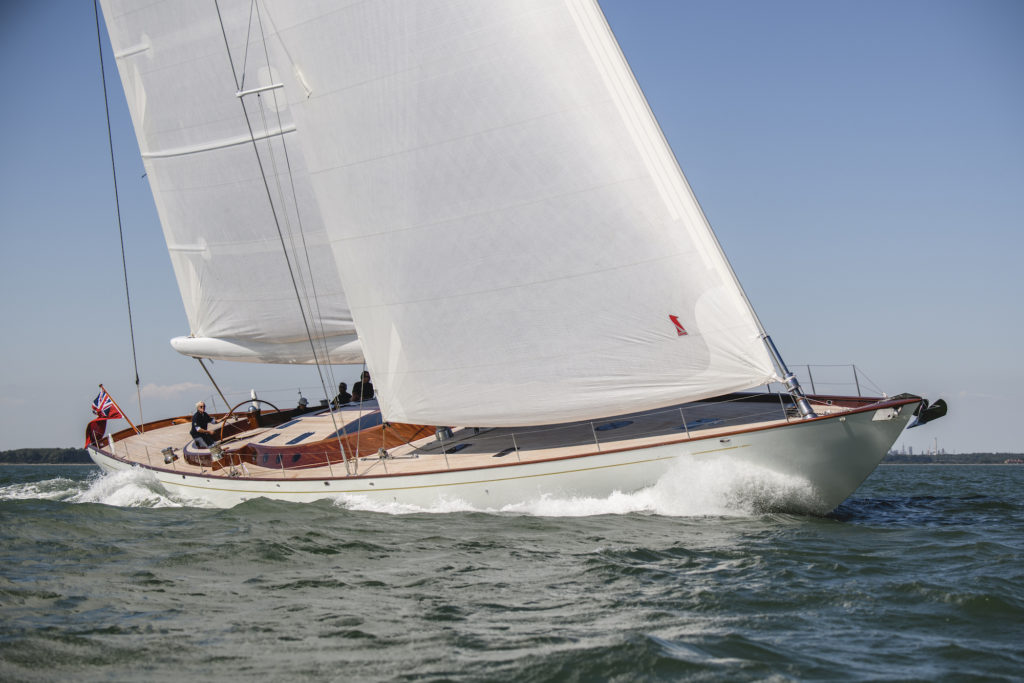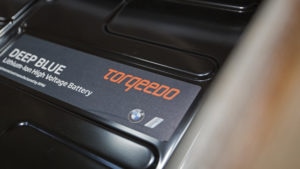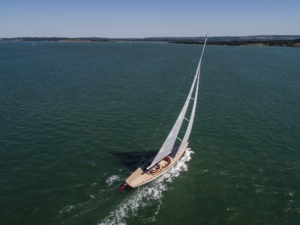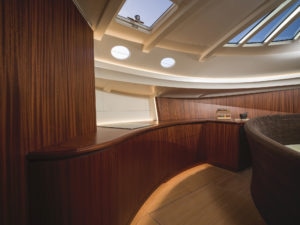Spirit Yachts unveils eco-friendly Spirit 111 superyacht

Spirit Yachts has unveiled its highly anticipated 34m sailing yacht, the Spirit 111. With eco features throughout and a stand-out interior design, the sloop-rigged yacht is the largest single-masted wooden sailing yacht to be built in the UK since Shamrock V in the 1930s.
At the request of her overseas buyer, the Spirit 111 has been designed and built in-house by Spirit Yachts to be one of the most environmentally friendly sailing superyachts ever created.
“Showcasing the Spirit 111 under sail and revealing her unique interior is a real milestone for the company,” says Spirit Yachts MD Nigel Stuart. “The yacht is incredibly complex in her design and engineering and we are very proud of what we have delivered. It’s been a challenging journey, which has given us the opportunity to innovate and gain insight for future superyacht and eco-focused builds.”
 Spirit Yachts worked collaboratively with leading marine and automotive suppliers to deliver on the owner’s eco brief. A Torqeedo electric propulsion system using a 100kW motor will propel the yacht silently for up to 30nm at eight knots from battery power alone. While sailing, the propulsion system will regenerate the four BMW lithium battery banks by rotating the propeller shaft whilst the yacht is under sail. All power-consuming components have been selected to be highly efficient and will use minimal energy without impacting performance or comfort.
Spirit Yachts worked collaboratively with leading marine and automotive suppliers to deliver on the owner’s eco brief. A Torqeedo electric propulsion system using a 100kW motor will propel the yacht silently for up to 30nm at eight knots from battery power alone. While sailing, the propulsion system will regenerate the four BMW lithium battery banks by rotating the propeller shaft whilst the yacht is under sail. All power-consuming components have been selected to be highly efficient and will use minimal energy without impacting performance or comfort.
“It is important to the owner that he can spend the majority of his time away from marinas enjoying sailing and anchoring in bays. Using electric propulsion to regenerate the batteries whilst sailing, the yacht will be able to operate for up to four days at anchor without having to plug into shore power or start the two onboard generators. When the yacht crosses the Atlantic, as long as there is adequate wind, she will not need to consume any fossil fuels,” says Stuart.
 “By partnering with suppliers and challenging ourselves to create customised solutions using the latest energy-saving technology, we have created one of the world’s most sustainable superyachts. From construction, using responsibly sourced timber to carbon-saving systems whilst in operation, the Spirit 111 sets a new standard for reducing the impact sailing has on our environment.”
“By partnering with suppliers and challenging ourselves to create customised solutions using the latest energy-saving technology, we have created one of the world’s most sustainable superyachts. From construction, using responsibly sourced timber to carbon-saving systems whilst in operation, the Spirit 111 sets a new standard for reducing the impact sailing has on our environment.”
The air conditioning uses variable speeds with eco options via battery or shore power and the galley has been designed with ultimate efficiency in mind. The fridge and freezer were built with Cryogel insulation to ensure minimal power consumption while holding low temperatures. Water is heated using a Webasto system, which only heats water on demand ensuring no wasted water or energy, and the heated water is stored within high density insulation and high efficiency transfer coils for rapid heat transfer and temperature retention.
The Spirit 111 is also one of few superyachts capable of cruising without professional crew. Energy efficient Lewmar hydraulic deck hardware and OneSails GBR (East) 4T FORTE™ sails made from materials that can be recycled are fitted to a Hall Spars carbon fibre mast and in-boom furling to facilitate short-handed sailing.
“A single-masted wooden yacht of this size that can be owner-driven is nothing less than a feat of engineering,” says Spirit founder and head designer Sean McMillan. “The yacht’s impressive strength to weight ratio, a carbon rig and lightweight, performance sails will allow the owner to compete at regattas worldwide.”
 The interior of the Spirit 111 was designed in partnership with Rhoades Young, which is Spirit Yachts’ first collaboration with an external design agency. Rhoades Young developed the initial concept for a unique, curved interior, which Spirit Yachts’ design team developed and brought to life in the final plans.
The interior of the Spirit 111 was designed in partnership with Rhoades Young, which is Spirit Yachts’ first collaboration with an external design agency. Rhoades Young developed the initial concept for a unique, curved interior, which Spirit Yachts’ design team developed and brought to life in the final plans.
Down below, walls and bulkheads flow in an ‘S’ shape through the interior, which has a natural look and feel thanks to the combination of the exposed Sipo, teak and American Walnut timbers on show. A bespoke, curved American Walnut seating arrangement takes centre stage in the open plan saloon-galley and C-shaped arrangements created from steamed timber curve over the beds in the owner’s and VIP cabins. Discreet doors with hidden, sensor-activated recesses, rather than visible door handles, ensure smooth lines and a contoured look throughout.
The smart lighting system onboard will complement the soft warmth of the wooden interior. “The interior has almost no light switches; motion sensors turn lights on and off during the day,” Stuart says. “At night, sensors under the beds detect if someone is up and light the way to the nearest ensuite. If a guest starts to go elsewhere within the interior, the system will deduce which way they are going and light the relevant areas in a very soft warm light.”
With no requirements for crew accommodation, guests have the choice of two double ensuite aft cabins or a starboard side double VIP cabin. The forward cabin holds the spacious master suite, complete with curved sofas built into the side of the hull, double bed and ensuite. All heads have rounded, solid timber sinks integrated into the worktop and power showers.











